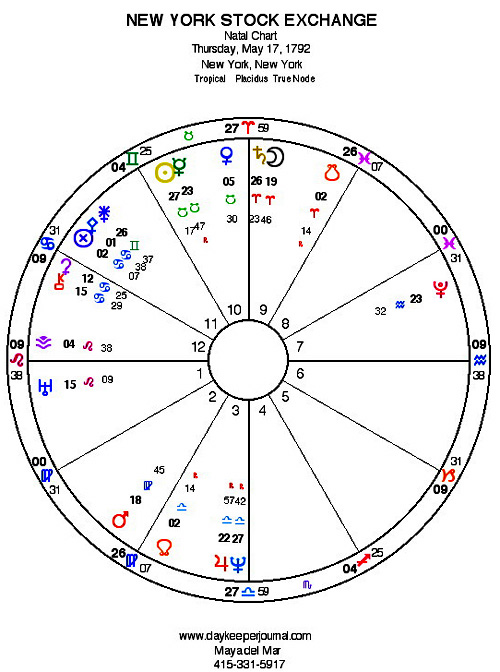
Can the stars and planets actually predict a Bull or Bear Stock Market? Predict the US Economy’s failures and success? Beginner’s guide to financial astrology is just that, a starting point for all of us to understand an unconventional way of looking at market trends and the health of the US economy.
Think about it Tarus (bull) is represented outside the building of the NYSE.
In case you don’t follow the US Stock Market I have linked an article explaining both a bull and bear market from Forbes for you to review (above).
And here is another investment link Investopedia, where I have learned most investment terms and what to do and what not to do. NEVER PANIC!!! Rule #1. Rule #2 don’t buy or sell on emotions. Markets will have its ups and downs…..
If you think you’re not already in the stock market, you are, if you have a 401k (for profit business) or 403(b) (non-profit business) through your work. You may just not have an individual account you advise on your own.
So hopefully I either empowered you to jump in the stock market with that statement or put you at ease knowing you’re already in the stock market.
Now, a friend of mine introduced financial astrology to me a couple of weeks ago and let me tell you as a Gemini I was intrigued (most Gems would be).
Let’s get the backstory and we’ll dive into this beginner’s guide to financial astrology.
Financial Astrology Backstory
W.D Gann: Gann Theory
According to Susan Gidel, Financial Astrologer, famous trader W.D. Gann is the pioneer of the concept. In fact, he used astrology, mathematics, geometry, and other unusual tools to predict and forecast the stock market back in the early 1900’s.
There’s an entire course on the Gann Trading Concept, if you’re interested. I find this astrologically fascinating.
Susan Gidel, states, Gann researched and traded both stocks and commodities at a time when he could have been arrested for being a “fortune-teller” in New York City.
Gann called his method of trading apart of “Natural Science.”
The concept intrigued JP Morgan, and American Investment Banker and billionaire who coined the statement, “millionaires don’t use astrology, billionaires do.”
Louise McWhirter: McWhirter Theory
And another pioneer is Louise McWhirter, who still today is the influencer in financial astrology. The McWhirter Theory.
The theory defines the strength of economic energy is based on the Moon’s north node, the point that is crossing the ecliptic into the northern ecliptic hemisphere.
The theory suggests that the U.S. economy tends to peak when the North Node is in the sign of Leo and tends to bottom when the North Node is in the sign of Aquarius, directly opposite. Both are part of an 18-year nodal cycle.
Foundation for the Study of Cycles
Edward R. Dewey
Some researchers have concluded that the Great Depression of the 1930’s planetary links were a direct key to the event.
Edward R. Dewey, the Chief Economic Analyst at the U.S. Commerce Department discovery in 1930 led him to form the Foundation for the Study of Cycles in 1941. And the organization stated in 2010: “We proved that the planetary signals were, in fact, the undeniable cause of cycles.”
Financial Astrology in Simple Terms
Here is a look at the New York Stock Exchange Natal Chart, created on May 17, 1792. Created, by Day Keeper Journal. What we know is key players are:
- Planets: Think of planets like characters in a story. Each has a role. For example, Mercury might be the news reporter, Venus the wealth bringer, and Mars the energy booster.
- Sun: Like the main character, the Sun represents the overall strength and confidence in the market.
- Moon: The Moon sets the mood. Its phases can indicate market sentiment – is it calm, exciting, or a bit unpredictable?

- Houses:
- Second House: This is the MONEY house. Its position in the astrological chart can tell us about financial stability.
- Eighth House: The house of shared resources and transformations. Changes here might signal shifts in the financial landscape.
- Aspects:
- Think of aspects like interactions between characters. Are they getting along (harmonious aspect) or having a disagreement (challenging aspect)? These interactions can suggest market trends.
- Moon Phases:
- Full Moons could be like the climax in a story – high emotions and increased market activity.
- New Moons might be the beginning of a new chapter – a quieter, reset period.
Some use financial astrology as having an extra guide to how the markets will react to the energy of the universe.
How to Relate to Financial Astrology
What I have read so far, it’s really no different than reading into Western or Vedic astrology, but you do have the 2 houses that are significant both the 2nd house and 8th house, you would want to closely pay attention to.
Let’s look at it in a cosmic way using Mercury “The Communicator.”
The Cosmic Report
It was a bright morning in the financial cosmos, and Mercury, the swift messenger planet, took center stage in the Second House – the cosmic realm of money.
Investors eagerly tuned in to Mercury’s financial news report. As Mercury formed a harmonious aspect with Venus, the wealth-bringer, it was as if they were co-anchoring a segment on financial prosperity. News of positive economic indicators and successful business ventures spread like wildfire.
However, the plot thickened as Mars, the energetic planet, entered the scene. Mars, in a square with Saturn, signaled a clash of energies. Investors felt the tension, and the market experienced a brief period of volatility. It was like a dramatic twist in the cosmic storyline.
As the lunar cycle progressed, a Full Moon illuminated the sky. Emotions ran high, and the market witnessed increased activity. Traders navigated the lunar waves, seizing opportunities presented by the heightened energy.
The Eighth House, representing shared resources and transformations, played a pivotal role. A conjunction between the Sun and Jupiter in this house signaled a period of significant financial transformations. It was akin to a turning point in the cosmic narrative – mergers, acquisitions, and strategic shifts in investment strategies unfolded.
Investors, armed with insights from the celestial events, adjusted their portfolios accordingly. The cosmic market report, influenced by the positions of these celestial characters, guided them through the twists and turns of the financial cosmos.
Wow! That was fun. I love a good cosmic ride.
Final Cosmic Thoughts
In this beginner’s guide to financial astrology, I am intrigued to say the least. And if JP Morgan can use astrology as a guide to make billions, I’m sure it’s worth more research for myself and others to be successful as well.
No success has ever been realized by sitting on the sidelines.
What I found in this research is financial astrology provides a novel lens through which to view market trends. However, its predictive efficacy remains a subject of debate within the financial community.
As investors navigate the complexities of the financial world, a balanced and informed strategy that combines diverse analytical approaches will continue to be the cornerstone of successful decision-making.
However, in my opinion, a little unconventional risk taking can also be considered.
In the ever-evolving ups and downs of financial markets, the cosmic narrative adds a layer of intrigue.
Whether one chooses to incorporate celestial insights or not, the pursuit of financial understanding remains a dynamic journey. May your investments be guided by a fusion of wisdom from both the earthly and cosmic spheres. Some risks are worth taking, in my opinion. In this beginner’s guide to financial astrology, I believe, the stars and planets do align. (Written by a Gemini).
Disclaimer: I am a novice trader with interest in financial astrology. Please seek additional wisdom as I am doing the same.
Related Stories
UNVEILING HIDDEN STRENGTHS IN ENNEAGRAM TYPES
CRYSTAL VISIONS FOR CAREER SUCCESS
We’ll chat soon,

